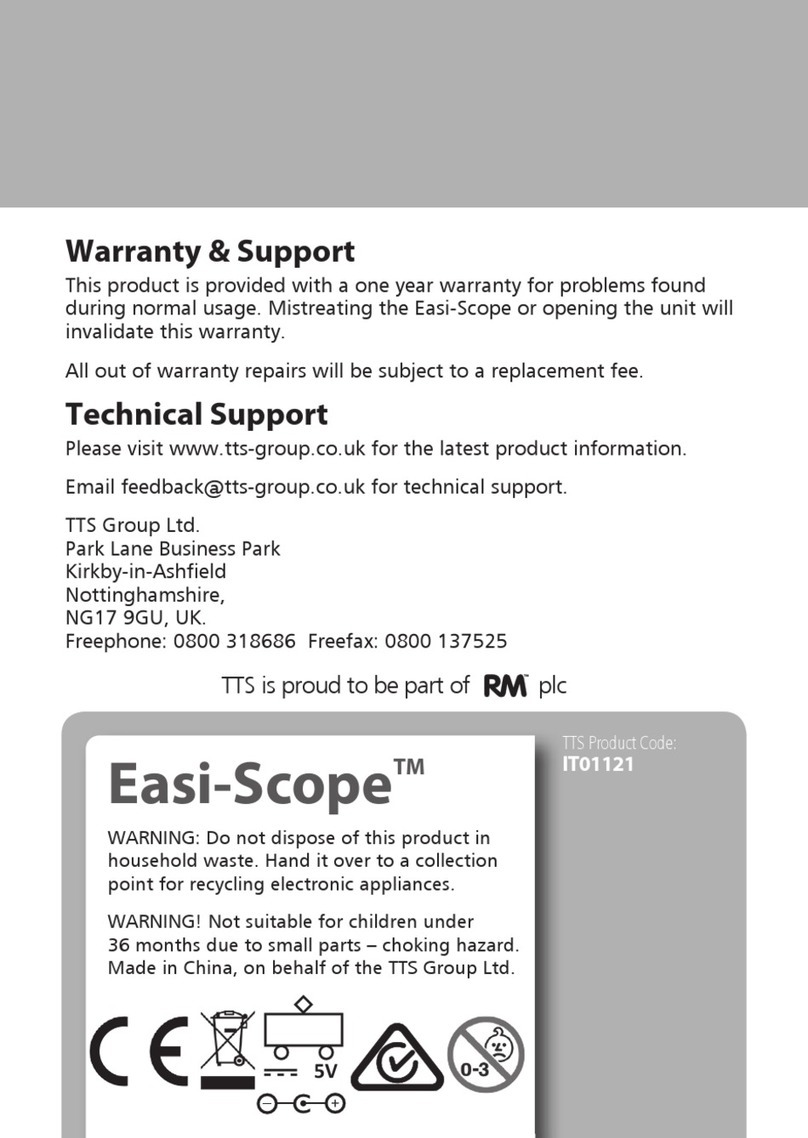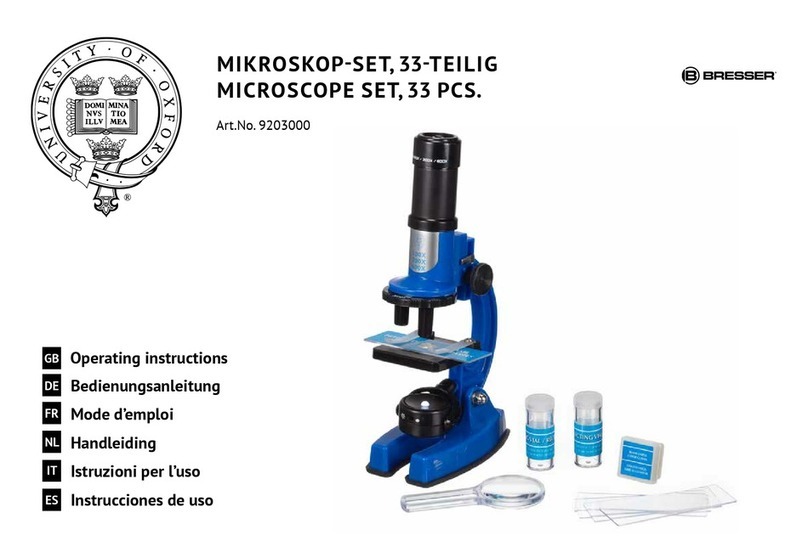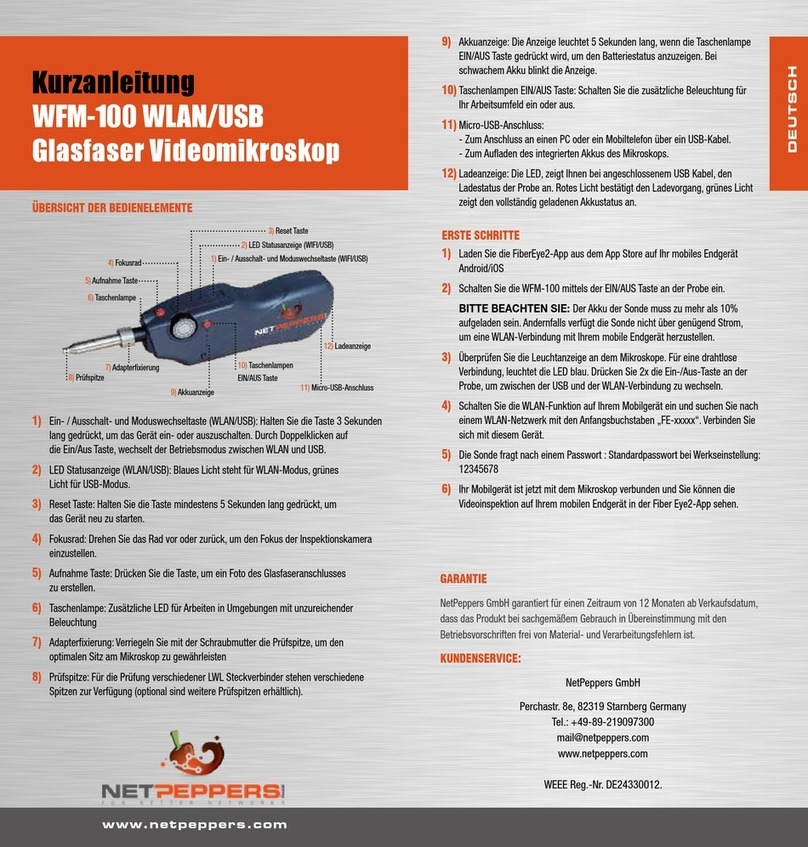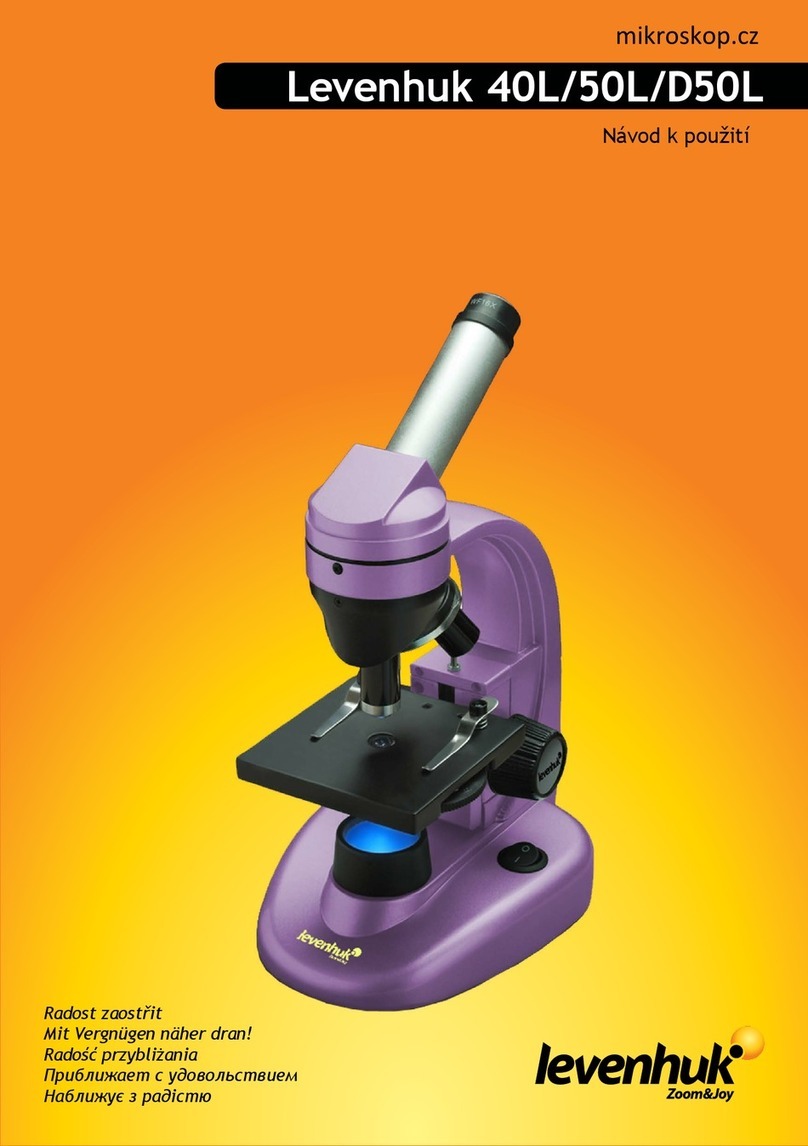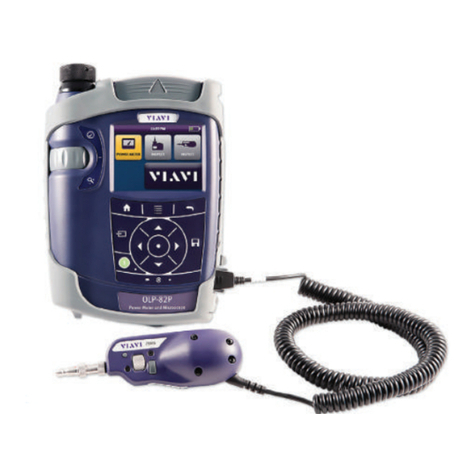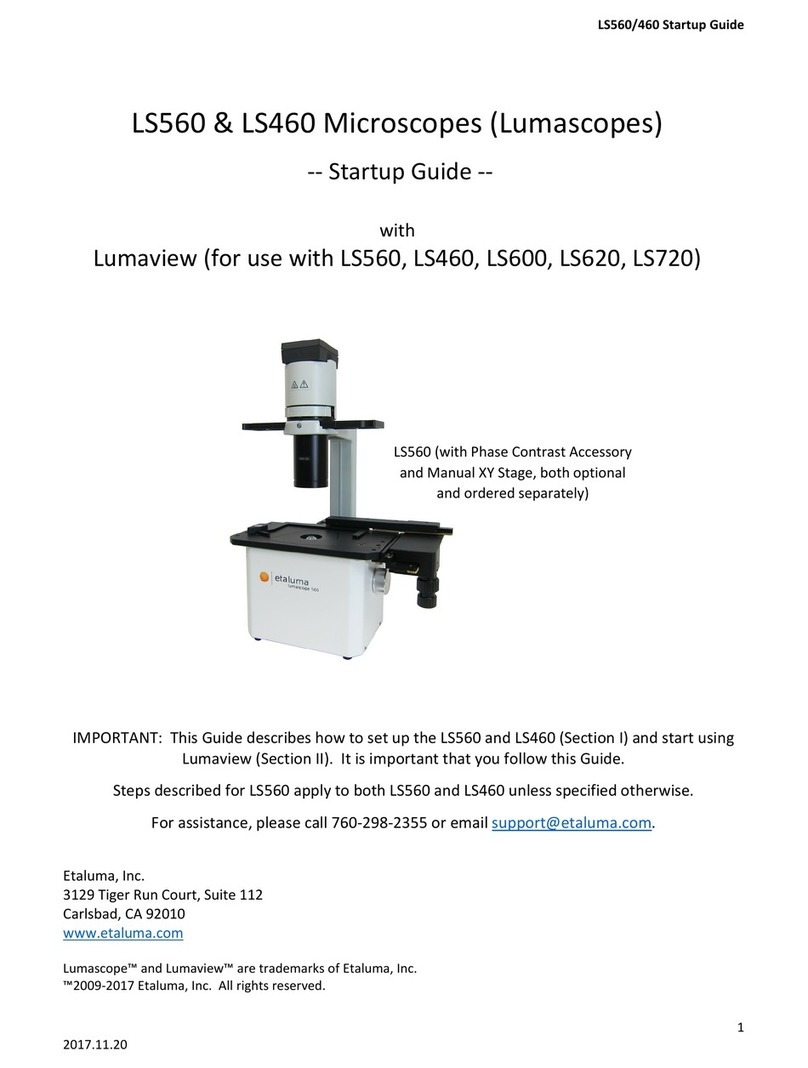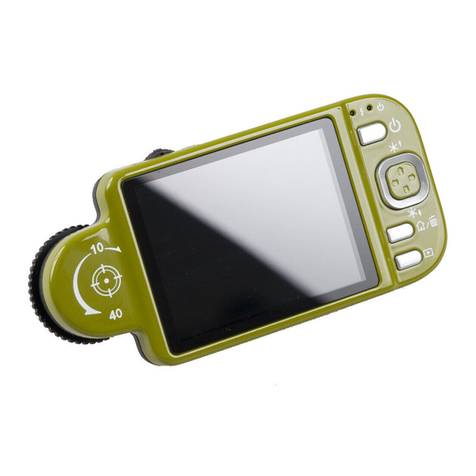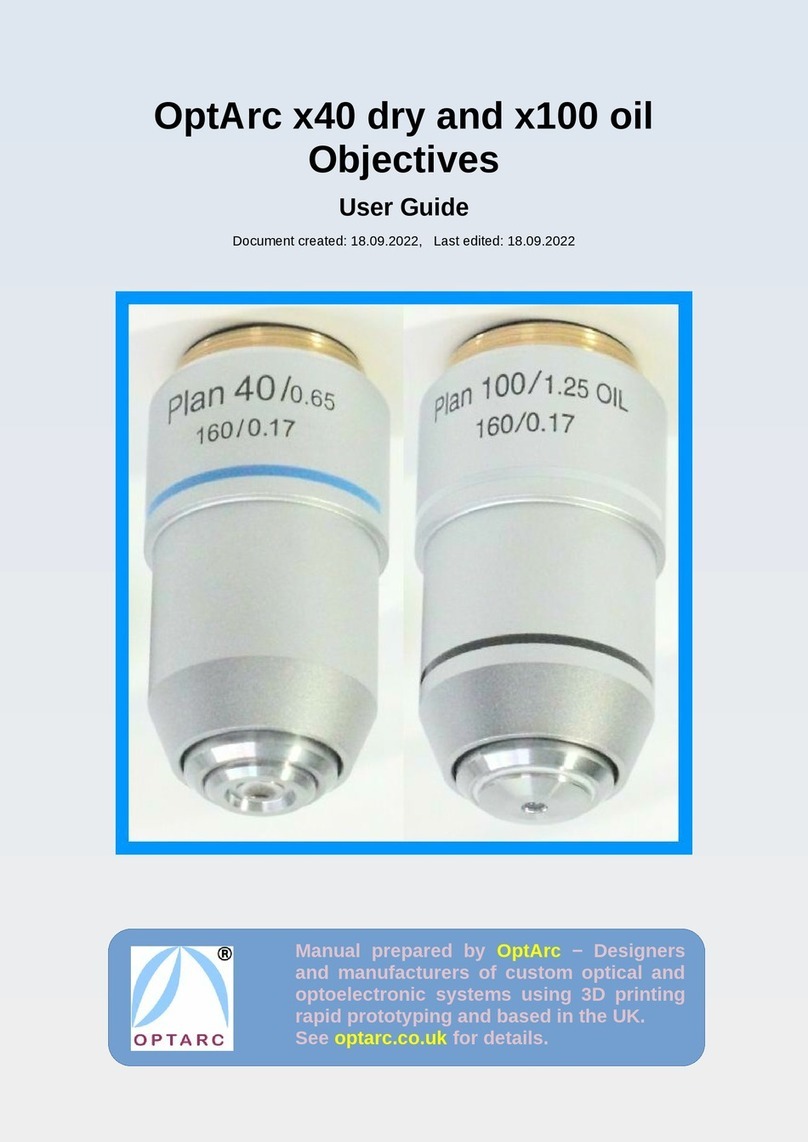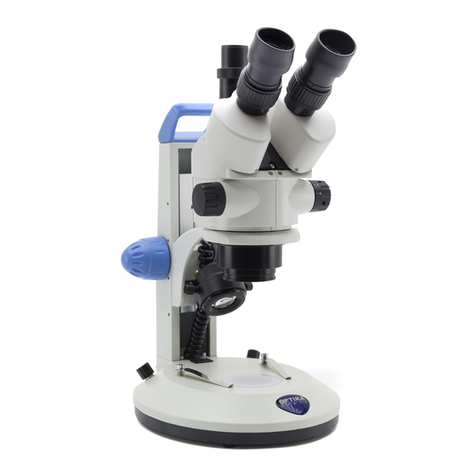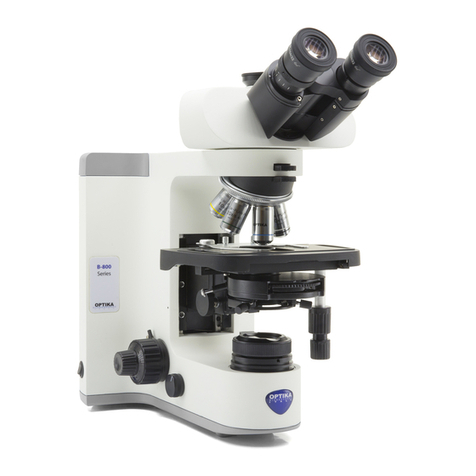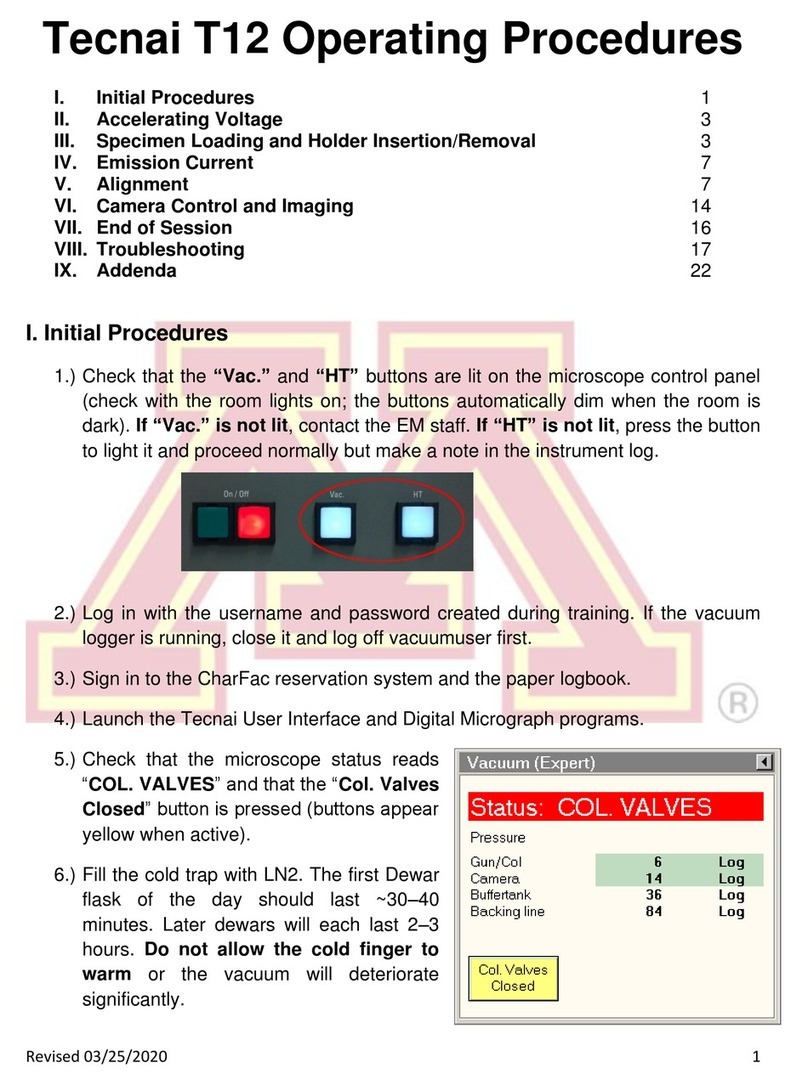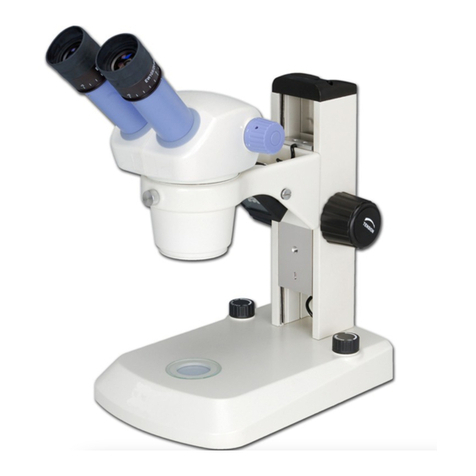Gema ST-40 Series User manual

Gem-A Portable
Microscope

23
Introduction
The Gem-A Travel Microscope is a compact instrument that is fully
rechargeable and comes already assembled with a travel case.
The travel case interior also contains spaces for a Gem-A refractometer,
LED lamp and the Gem-A Portable Instrument Kit, allowing for easy
transportation of the gemmologist’s essential tools.
This microscope uses LED lighting, the benefits of which include:
No heat generation
Whiter light (instead of tungsten, meaning photographs of inclusions will
require less colour adjustment).
Longer bulblife (20,000 of hours of use).
Please note: Microscopes are a precision instrument, so always handle
with care and avoid impact or abrupt movement during transportation.
The Gem-A Travel Microscope belongs to the ST-40 series.
Before use
Before setting up the Gem-A Travel Microscope please ensure that the
area you intend to use is clean and dry and that the environment is
between 0-40°C, with a maximum relative humidity of 85%. Never expose
the microscope to direct sunlight, high temperatures or strong vibrations.
Check to ensure the power supply voltage is consistent with your
microscope’s voltage rating before use (see page 10).
Please note: The microscope may require a partial recharge before its first
use.
Gem-A Portable Microscope
Set-up
Place the case on a flat, level surface and open it, taking care to ensure
any pieces that may have come loose do not slip out. Check that the
microscope and its accessories are all present and undamaged.
The Gem-A Travel Microscope kit includes:
1 plastic cover
1 travel case with keys
2 rubber eye-guards
2 10× eye-pieces
2 20× eye-pieces
1 gemstone holder
1 UK transformer plug and lead
Remove the microscope from its case and position it in the space you
intend to use it. Please make sure the surface you place it on is flat and
level. It may be helpful to have a power source nearby for the first use.
Avoid touching the lenses; this will help to keep the image clear and
reduces the risk of scratching.

45
Operating the microscope
n
k
c
a
b
g
j
l
m
f
d
i
e
h
o
i. SETTING THE SPECIMEN
Place the specimen down on a flat surface
Using the stone holder, clasp the specimen on either side, making sure it
is held securely between the stone holder clips (a).
Slot the stone holder into one of the stone holder posts (b). Try both
sides to see which you feel most comfortable with.
ii. ILLUMINATION
Remove the white cap from the turret section that holds the objective
lenses of the microscope (c).
Tip: Use the white cap to produce a diffused white light by placing it over
the iris diaphragm.
If necessary, plug the microscope into a power source (d), then turn the
microscope on by pressing the ON/OFF switch on the left-hand side (e).
N.B.: When the microscope is recharging the ‘ON’ button appears red;
when it is no longer connected to a power supply it will turn green.
The right hand dial (f) controls the two light sources in the following way:
I - controls the main light only
II - controls the overhead light only
III - controls the main light and the overhead light simultaneously.
LABELS:
a - Stone holders
b - Stone holder post
c - Objective lens
d - Outlet
e - On/off switch knob
f - Light control knob
g - Rheostat knob
h - Iris diaphragm
i - Lever for iris diaphragm aperture
j - Movable eyepiece holder
k - Zoom turret
l - Eye piece focus knob
m - Dioptre adjustment
n - Left eyepiece
o - Right eyepiece

67
The rheostat control on the left-hand side of the base unit controls the
light intensity (g).
The dark-field unit is supplied with an iris diaphragm (h); it can be
widened or narrowed to adjust the amount of light coming through by
moving the handle (i) around the iris.
iii. ADJUSTING THE INTER-PUPILLARY DISTANCE
The microscope head has movable eyepiece holders (binoculars) that
move from side to side, allowing you to alter the width of the eyepieces to
your ideal position (j).
iv. ADJUSTING THE MAGNIFICATION
The Gem-A Travel Gem Microscope uses a turret system which houses
two objectives of 1× and 3× magnification. When combined with the
eye-pieces, the following magnifications can be attained: 10×, 20×, 30×
and 60×.
To alter the magnification turn the black turret (k) until you feel it click
into place.
The extra 20× eyepieces will allow higher magnifications of 20× and
60×. To change the eyepieces unscrew the small holding screws (l) and
pull the 10× eyepieces out. Replace them with the 20× eyepieces. You
do not need to re-tighten the screws unless the microscope is going to
be moved.
v. ADJUSTING THE FOCUS
Push the stone holder on to the fitting on the base of the microscope
and look through the microscope at the tips of the stone holder clips.
Close the right eye and rotate the focus knob (l) until the image is sharp
and clear.
For fine focus adjustment, close the left eye and look at the tips of the
stone holder clips, twisting the dioptre adjustment on the left-hand
eyepiece (m) until the tips are focused.
Open both eyes and check: the microscope is now set up for your
personal use.
vi. CHANGING THE SLIDE-IN OBJECTIVE LENSES
Loosen the lock-screw on the objective mount and pull out the objective
vertically.
Insert an alternative objective into the correct position.
Re-tighten the lock screw.
Please note:
The microscope requires 8–10 hours for a full recharge
The actual operation time after a full recharge depends on the settings
used.
It will last 6–8 hours at full capacity when used normally, and
approximately 4 hours if all the LED lights are turned on and set to
maximum intensity.
Always turn the lights off after use. When the microscope has finished
charging unplug the mains lead from the wall socket.
N.B.: The microscope has rechargeable batteries inside, it is therefore
extremely important to unplug the mains once the microscope has
recharged.
Operating the microscope (cont.)

89
If you have any problems with your microscope please contact us at
returning the microscope, as we may be able to rectify or advise on the
problem.
Troubleshooting
Optical
Problem Possible Cause Solution
Dirt obscuring the
field of view
Dirt on the specimen Clean the specimen
Dirt on the surface of the lenses Clean the lenses
Dirt on the surface of the objective
lens
Clean the objective lens
Doubling of images
Wrong interpupillary distance Readjust the eyepieces
Wrong dioptre adjustment Readjust the dioptre
Different magnification Mount the same size eyepieces
Blurry image Dirt on the surface of the objective
lens
Clean objective lens
Incision image The objective and light source are
not fully aligned
Adjust the objective to the correct
position
Electrical
Problem Possible Cause Solution
LED not working
No power Connect to mains to recharge the
battery. If there is no power after
charging then replace the batteries
in the battery compartment inside
the base. Open the bottom plate by
unscrewing 4 locking screws at the
rubber feet.
The LED has reached the end of
its life
Replace it
The fuse has burned out Replace it
Fuse burning out
very quickly
The voltage is too high Use a transformer to lower the
voltage
Care and maintenance
Always cover the microscope with the plastic cover provided after use and
store it in a clean and dry place, free from moisture to prevent rust.
Lenses:
All lenses must be kept clean to avoid damage to the glass surfaces.
Fine dust on the surface of the lens should be blown off with hand
blower or wiped off gently with a soft lens tissue.
Fingerprints or oil marks should be wiped off with a lens wipe.
Surfaces:
Never use an organic solution to clean the surface of the microscope,
especially the plastic surfaces.
If it is absolutely necessary to clean them, please use a neutral
detergent.

10 11
Technical specifications
Rated Voltage 100V-240V
Rated Power 4W
Rated Frequency Auto adapts both 50Hz/60Hz
Protection Class 1
Operating Temperature 0-40 C
Relative humidity 10-85%
User replaceable fuses Double fuse design used.
Each fuse has 1A rating.
Rechargeable batteries Standard AA size Ni-Mh type with
modern LSD (Low Self-Discharge)
technology by which 80% of the
power could be retained even after
1 year.
Industry highest capacity 2700mAh
each. Total 4 pcs in a gemscope,
making it a massive 10,800mAh
total.
Easily replaceable in a battery
compartment inside the base.
Just open the bottom plate by
unscrewing 4 locking screws at the
rubber feet.
WARNING
This microscope is not designed for use with immersion liquids.
Using an immersion cell with this microscope is done at your own risk.
Please do not take the microscope apart if you fear it is damaged.
Servicing of the unit should be done only by a qualified person or returned
to the supplier.
The supplier does not accept any responsibility for damage or harm
caused by not strictly observing the safety requirements and instructions
in this manual and any other supplied documentation, or by negligence
during installation, use, maintenance or repair of the units.
The Gem-A Travel Gem Microscope comes with a 1 year warranty. If you
need to contact Gem-A regarding your microscope please make sure you
have either a copy of your invoice or your student number and year of
enrolment to hand.

A company limited by guarantee and registered in England No. 838324. Registered
ofce: 3rd Floor, 1–4 Argyll Street, London W1F 7LD. VAT Reg. No.: 995 8813 45.
Gemmological Instruments Ltd is a wholly owned subsidiary of The Gemmological
Association of Great Britain (UK Registered Charity No. 1109555).
Join us.
Table of contents



